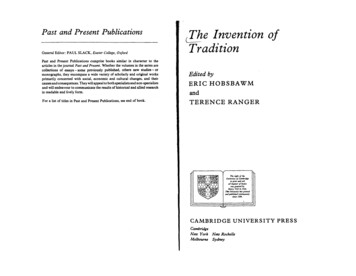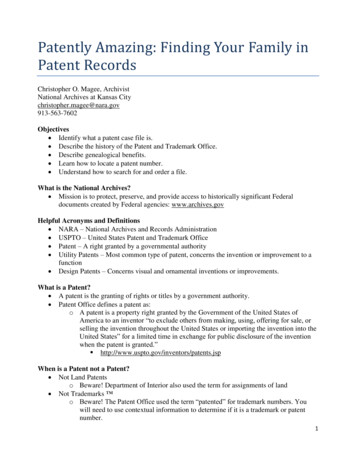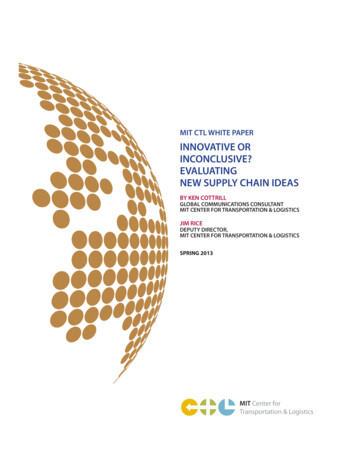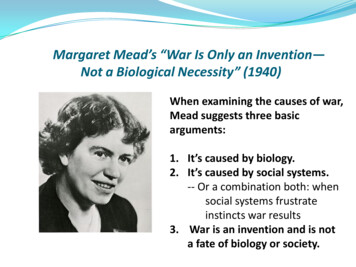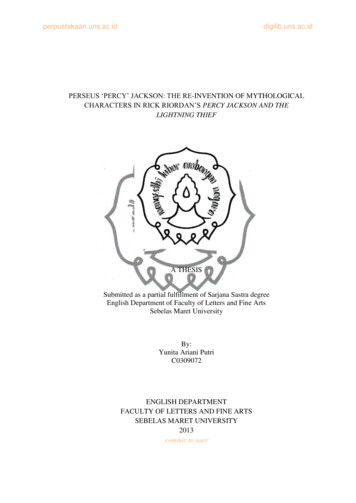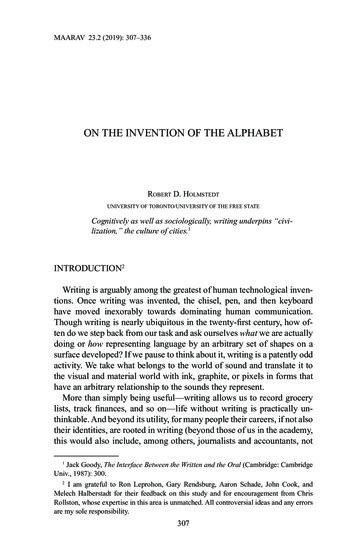
Transcription
MAARAV 23.2 (2019): 307–336ON THE INVENTION OF THE ALPHABETRobert D. HolmstedtUNIVERSITY OF TORONTO/UNIVERSITY OF THE FREE STATECognitively as well as sociologically, writing underpins “civilization,” the culture of cities.1INTRODUCTION2Writing is arguably among the greatest of human technological inventions. Once writing was invented, the chisel, pen, and then keyboardhave moved inexorably towards dominating human communication.Though writing is nearly ubiquitous in the twenty-first century, how often do we step back from our task and ask ourselves what we are actuallydoing or how representing language by an arbitrary set of shapes on asurface developed? If we pause to think about it, writing is a patently oddactivity. We take what belongs to the world of sound and translate it tothe visual and material world with ink, graphite, or pixels in forms thathave an arbitrary relationship to the sounds they represent.More than simply being useful—writing allows us to record grocerylists, track finances, and so on—life without writing is practically unthinkable. And beyond its utility, for many people their careers, if not alsotheir identities, are rooted in writing (beyond those of us in the academy,this would also include, among others, journalists and accountants, not1Jack Goody, The Interface Between the Written and the Oral (Cambridge: CambridgeUniv., 1987): 300.2I am grateful to Ron Leprohon, Gary Rendsburg, Aaron Schade, John Cook, andMelech Halberstadt for their feedback on this study and for encouragement from ChrisRollston, whose expertise in this area is unmatched. All controversial ideas and any errorsare my sole responsibility.307
308MAARAV 23.2 (2019)to mention the social-media obsessed). Indeed, we now live in a worldso dominated by the imprinted form of writing (no doubt well past whatGutenberg could have imagined) that to say that writing is “useful” maybe the understatement of the century. Even if we peeled some of theselayers back, writing would remain an essential part of our existence,since, as John Searle opines, writing and civilization go hand-in-hand:. . . the big step between us and animals is in the language. Butthe big step between civilization and more primitive forms ofhuman society is written language. . . . It is a constitutive element of civilization in that you cannot have what we think ofas the defining social institutions of civilization without havingwritten language. You cannot have universities and schools.But not just the pedagogical institutions, but you can’t evenhave money or private property or governments or nationalelections . . . without a written language.3Note Searle’s distinction between language and writing. Humans aregenetically wired to acquire and use language, even in contexts that donot provide a wealth of language stimulus. But we must learn writing,and though it is easy to forget what it was like during those first yearsof grade school, it takes a great deal of work and time to master writing,which requires manual dexterity and abstract cognitive processing; and itis worth noting that the same abstractness and difficulty of mastery applyto the cognate activity of reading.4 The point is that we cannot exaggeratethe creativity of those who innovated writing systems.Searle’s description has a noticeably modern cast to it, but much of itis applicable to the world before the iPhone, the personal computer, theelectric typewriter, the printing press, or codices. His description addresses the why of the story—complex institutions are the necessary and sufficient condition for the use (or, initially, the innovation) of writing. (Andit may well be that writing is a necessary condition for sustaining complexinstitutions.)5 The historical question this prompts concerns the who.3John Searle, “Language, Writing, Mind, and Consciousness. Interview with JohnSearle, 29 June 2005,” Children of the Code, 2005, m; see also Barry B. Powell, Writing: Theory and History of theTechnology of Civilization (Oxford: Wiley-Blackwell, 2009): 18.4See Michael P. O’Connor, “The Alphabet As a Technology,” in The World’s WritingSystems (Peter T. Daniels and William Bright, eds.; New York: Oxford Univ., 1996): 787;Christopher A. Rollston, Writing and Literacy in the World of Ancient Israel: EpigraphicEvidence from the Iron Age (SBL Archaeology and Biblical Studies 11; Atlanta: SBL,2010): 68–69.5Peter T. Daniels points out that the Incas of Peru had a complex civilization, but did
HOLMSTEDT: INVENTION OF THE ALPHABET309For the independent development of writing itself, there are threeknown places of initial invention: the great ancient civilizations of Sumer(fourth millennium b.c.e.) and China (second millennium b.c.e.), and thelater great civilization of the Mayans (first millennium b.c.e.). Somealso include early dynastic Egypt on this list—whether completely independently or by stimulus diffusion, resulting in four initial innovatorsof writing.6 All other systems are arguably derived from or inspired bythese three or four first systems. But these earliest systems are syllabariesthat emerged from logographies, which leads us to the next question andthe question at the heart of this essay: who invented the alphabet?7The where of the alphabet seems clear enough: the earliest examples ofalphabetic writing come from locations in Egypt and the Sinai Peninsula,dating from the mid-nineteenth century b.c.e. (for the Wadi el-Hol inscriptions) to the sixteenth century b.c.e. (for the Ṣerâbîṭ el-Khâdim inscriptions). The who and why of the earliest alphabetic texts is where thesleuthing begins. Among the various proposals, a very recent one standsout, if for no other reason than its audacity: the creators and the languageof the texts were Hebrew.8Is it plausible that the “Hebrews” innovated the alphabet in the early second millennium b.c.e.? If not the Hebrews, who else might haveachieved this technological advance?not record their language (“The Invention of Writing,” in The World’s Writing Systems[Peter T. Daniels and William Bright, eds.; New York: Oxford Univ., 1996]: 585); however,continued research on the Inca quipus (the knotted cord system of recording) leaves openthe possibility that the quipu system may have recorded some language information (seeSabine Hyland, “Writing with Twisted Cords: The Inscriptive Capacity of Andean Khipus,”Current Anthropology 58.3 [2017]: 412–419).6Christopher Woods, “Introduction—Visible Language: The Earliest Writing Systems,”in Visible Language: Inventions of Writing in the Ancient Middle East and Beyond(Christopher Woods, ed.; Chicago: OI, 2010): 15–25.7Throughout this essay, I use the term “alphabet” purely for convenience, since that itthe term most readers will be familiar with. Yet Daniels (Peter T. Daniels, “Fundamentalsof Grammatology,” JAOS 110.4 [1990]: 727–731) makes a compelling case (now adoptedin many typologies of writing systems) that the Hebrew “consonantary” (which he coins an“abjad”) should be distinguished from the Greek style alphabet (consonants and vowels),which are both different from the consonant vowel script used for Ethiopic (which he callsan “abugida”).8Douglas Petrovich, The World’s Oldest Alphabet: Hebrew as the Language of theProto-Consonantal Script, with a contribution by Sarah K. Doherty and introduction byEugene H. Merrill (Jerusalem: Carta, 2016).
310MAARAV 23.2 (2019)WRITING AS A TECHNOLOGYApart from the oft-forgotten challenges of learning to read and write, itis also important for one to recognize the fundamentally abstract natureof writing. While the means of visually representing things and activitiesis found in the earliest human records (e.g., cave paintings, clay tokensto record goods9), visually representing words, groups of sounds (e.g.,syllables), or even individual sounds is a relatively recent developmentfor humans. All but the most abstract artwork retains some iconic relationship to the object represented, and though writing seems to have hadan initial iconic quality, developed writing systems are far from iconic.This is especially true of alphabetic writing.Moreover, as psycholinguistic research on the relationship of orthography and the process of reading has begun to turn its attention away fromlanguages with alphabetic writing systems, the status of the phoneme asdominant in writing has rightly been questioned.10 Contrary to commonassertion, the alphabet is not an inherently better or more economicalwriting system—this view reflects ignorance, prejudice, and an alphabetic chauvinism.11 The research suggests that, instead of the phonemeas the primary vehicle of reading, it is the syllable that humans morereadily recognize.12 While an alphabet may be more economical in termsof the number of distinct written signs, syllabaries are more economical9On the relationship between the clay tokens found in Mesopotamia from the ninth tofourth millennia b.c.e. to the development of cuneiform writing, see Christopher Woods,“The Earliest Mesopotamian Writing,” in Visible Language (n 6): 45–48.10David Braze and Tao Gong, “Orthography, Word Recognition, and Reading,” in TheHandbook of Psycholinguistics (Eva M. Fernández and Helen Smith Cairns, eds.; Oxford:Wiley-Blackwell, 2018): 269–293.11Peter T. Daniels, “The First Civilizations,” in The World’s Writing Systems (n 5):26–28.12David L. Share, “Alphabetism in Reading Science,” Frontiers in Psychology 5.752(2014): 1–4, 2014.00752. Note alsoDaniels’ statement two decades earlier:the result of the process is always a syllabary emerging from logography, never analphabet. . . . This phenomenon seems to originate in the way people use and processspeech: various psycholinguistic and phonetic observations and experiments indicatethat it is in syllables and not any shorter stretches of speech (i.e., “segments,” theresult of phonological analysis and roughly equivalent to letters of the alphabet) thatpeople can consciously hear—unless they have learned to read in an alphabetic script(Daniels, “The Invention of Writing” [n 5]: 585).Michael P. O’Connor also cites studies from 1934 and 1969 to support the assertion that“the phoneme is itself a by-product of the alphabetic system it is so often made to explain”(Michael P. O’Connor, “Writing Systems and Native-Speaker Analyses,” in Linguisticsand Biblical Hebrew [Walter R. Bodine, ed.; Winona Lake: Eisenbrauns, 1992]: 232–233).
HOLMSTEDT: INVENTION OF THE ALPHABET311in terms of the cognitive processing involved in reading. The distinction between how we perceive language psycho-acoustically (i.e., thatwords and syllables have greater “reality” than phonemes) highlights thedistinction between how language works deep in the mind and how weperceive it in pre-theoretical ways. Reading and writing language are notnatural in the same way that speaking and hearing language are.Just as we must distinguish the process of writing versus speaking, soalso should we distinguish the name of a writing system from the nameof the language it represents.13 For instance, we refer to our language asEnglish and our alphabet as the English alphabet. But there are multipledialects or grammars that we conveniently call English and the alphabet we use for all of them is actually the Latin alphabet, itself derivedfrom Greek, which was borrowed from Phoenician.14 Indeed, the earliestknown writing system in Mesopotamia, established by the Sumerians,was borrowed by others to write a completely unrelated language,Akkadian. We will return to the issue of naming at the end of this essay.That writing is part of an analytical process and not inherently attachedto a linguistic system, a particular language, likely explains the nearlysimultaneous advent of the formally unrelated Sumerian and Egyptianwriting systems. Writing systems can be borrowed and adapted to languages they were not created for; even more so, the idea of writing iseasily transferable.15 The traveling nature of the idea of writing lies at theheart of the innovation of alphabetic writing.TOWARDS THE INVENTION OF THE ALPHABETRecording information in increasingly complex and increasingly urban environments seems to be the motivation for the advent of writing,which we trace to the late fourth millennium in southern Mesopotamia,if not also simultaneously in the Nile Valley. Although the earliestMesopotamian texts cannot be fully read, because the signs can be13Michael P. O’Connor, “Epigraphic Semitic Scripts,” in The World’s Writing Systems(n 5): 88–89.14See Powell (n 3): 6–7.15“If writing represents a variety of delinguistic behavior, rather than a special varietyof linguistic activity, it is at least as likely for the notion of a writing system to be borrowedas for the system itself to be taken over” (Michael P. O’Connor, “Writing Systems, NativeSpeaker Analyses, and the Earliest Stages of Northwest Semitic Orthography,” in The Wordof the Lord Shall Go Forth: Essays in Honor of David Noel Freedman in Celebration ofHis Sixtieth Birthday [Carol L. Meyers and M. O’Connor, eds.; ASOR, No. 1; WinonaLake: Eisenbrauns, 1983]: 441).
312MAARAV 23.2 (2019)connected to later forms, it is generally agreed that they are in originSumerian.The writing is linear and consists of picture-like signs inscribed onclay tablets. Many of the symbols are pictographic—each sign represents an object, such as a stalk of grain for wheat or a circle with a crossfor a sheep. However, other signs represent the abstraction of writing.That is, a sign that depicts an object could also be used to represent theword, that is, the articulated sound of the name for the object. For example, if English had used a logography (or, as in the game of Pictionary), adrawing of an eye () could also be used of the pronoun “I,” a can ( )used for the modal verb “can,” waves () representing the sea usedfor the verb to “see,” and so on.More than a game, this was an important path of development from alogographic writing system to one that also incorporated syllables. So, inSumerian, the picture of an arrow /ti/ became used not only for the (near)homonym, /ti(l)/ “life,” but also for the syllabic sound segment /ti(l)/,which could be used as one segment in a multi-syllable word. Similarly,the picture of a garden /sar/ came also to be used for the verb /sar/ ‘towrite’. This process employs the rebus principle, or “phoneticization.”Finally, Sumerian added to these layers a special kind of sign to indicate word classes, such as “human,” “god,” or “city.” The result was anelaborate system of just under two thousand logographs (“word signs”),syllabographs (“syllable signs”), and determinatives (“class signs”).As the writing system was used over time, it became more stylized,and the signs lost their pictographic quality by becoming more abstractand linear (fig. 1).16 This is what most people know and study as cuneiform (“wedge-shaped”) script, which was created for Sumerian but thenadopted for the Babylonian and Assyrian forms of Akkadian.A similar story of writing development occurred at roughly the sametime in Egypt. And it is Egyptian writing that appears to have been modified into an alphabetic system. Scholars of the ancient Near East have longknown about and discussed the role of apparently alphabetic inscriptionsdiscovered in various locations in Egypt and the Sinai Peninsula (fig.2).17 They attracted the attention of notable scholars like the EgyptologistAlan Gardiner and Northwest Semitic specialist William F. Albright, andthe latter’s student Frank Moore Cross, followed by at least two generations of students in the Cross-ian tradition.Though some features of the texts still defy interpretation, a consensusemerged fairly early that these early alphabetic forms were derived from16Woods, “The Earliest Mesopotamian Writing” (n 9): 38, fig. 2.5.17Petrovich (n 8): x.
HOLMSTEDT: INVENTION OF THE ALPHABET313Figure 1: Evolution of Cuneiform (Christopher Woods)Egyptian writing and used for a West Semitic language. The ensuingdiscussion centered primarily on whether the letter forms were derivedfrom hieroglyphic or hieratic and, of course, on the identity of the innovators.18But before we can address the who of this new alphabet, it is importantto note that it was not the only innovation at this time. Intriguingly, twowriting system innovations appeared at roughly the same time and in theancient Near East. Moreover, from what we can deduce, both representessentially the same type of language: some second millennium WestSemitic language.The earlier of the two writing systems appears to be a syllabary, notan alphabet. But, unlike the alphabetic texts, the syllabic texts are moreclearly associated with a speech community: Byblian Phoenicians. Inthe late 1920s fourteen texts inscribed on bronze tablets and carved instone were discovered during excavations at the ancient Phoeniciancity of Byblos.19 The bronze tablets in particular were found in a clear18For an overview of scholarship, see Gordon J. Hamilton, The Origins of the WestSemitic Alphabet in Egyptian Scripts (CBQMS 40; Washington, DC: CBAA, 2006): 5–12.19Maurice Dunand, Byblia Grammata: Documents et recherches sur le developpement
314MAARAV 23.2 (2019)archaeological context that corresponds to the Egyptian Middle Kingdom(ca. 2050–1800 b.c.e.).Figure 2: Find sites of alphabetic inscriptions(Douglas Petrovich)de l’ecriture en Phenicie (Beyrouth: Ministère de l’Education Nationale et des Beauxarts, 1945): 139–157; James E. Hoch, “The Byblos Syllabary: Bridging the Gap BetweenEgyptian Hieroglyphs and Semitic Alphabets,” Journal of the Society for the Study ofEgyptian Antiquities 20 (1990): 115–124.
HOLMSTEDT: INVENTION OF THE ALPHABET315Due to the pictographic nature of the writing, the excavator called it“pseudo-hieroglyphic,” but it is now generally agreed that it is a syllabicwriting system,20 that is, an innovative system in which signs representonly consonant-vowel sequences, such as ba, bi, bu, etc. Unlike the previous writing systems, in which syllables could be represented by retasked logographs, this system has no apparent logographic layer. Thisinnovation is now typically called the Byblos syllabary and though thislate third or early second millennium writing system has not been entirely deciphered, enough likely correspondences have been determined toconsider it the first major writing innovation since the fourth millennium.Aside from hoping someone is able to finish the decipherment of thesetexts, either when additional texts are found or perhaps by the use ofcomputer-aided statistical analysis, the real question is, “Why?” If theByblians were the inventors, and the consensus is that this is the logicalconclusion given the find-spot of the texts, why did they feel compelledto develop a new writing system? Circling back to the necessary andsufficient causes for writing development helps us propose a reasonablebroad sketch.During the Old Kingdom period of Egypt (ca. 2700–2200 b.c.e.) therewas significant Egyptian trade with the new cities developing on thenorthern coast of the Levant, in modern Lebanon.21 Chief among thesecities, at least from the Egyptian perspective, was Byblos, or “Gubla”in its own language. In fact, “the earliest inscriptional evidence of anEgyptian king at the Lebanese site of Byblos belongs to the reign ofKhasekhemwy, the last ruler of the 2nd Dynasty.”22 And even beforethe Old Kingdom, one of the oldest buildings discovered in Egypt,“Narmer’s Temple” at Hierankopolis in Upper Egypt at the end of thefourth millennium (ca. 3400) was built with cedar timbers imported fromByblos.23 And First Dynasty rulers used Byblian timbers in the construction of their tombs.24Though the early history of Byblos has been largely neglected, a recent study points out that “a range of evidence suggests that Byblos wasa prosperous and powerful city during the Early and Middle Bronze20“It is possible that the Byblian system arose from an amalgam of a first-handknowledge of Egyptian (hieratic) writing and the knowledge that syllables could be writtenin Akkadian cuneiform” (Hoch [n 19]: 119).21Kathryn A. Bard, “The Emergence of the Egyptian State (c. 3200–2686 BC),” in TheOxford History of Ancient Egypt (Ian Shaw, ed.; Oxford: Oxford Univ., 2000): 58.22Ibid., 71.23Narmer’s Temple, Archaeology’s Interactive Dig, 2009, temple.html.24Bard (n 21): 71.
316MAARAV 23.2 (2019)Ages.”25 Byblos’ commercial prominence continued through the LateBronze Age, though if it was at least partially dependent on Egypt for itsstability, the end of the Old Kingdom and the ensuing decentralizationof the First Intermediate Period (ca. 2200–2050 b.c.e.) would very likelyhave brought about changes.This period of instability may be the crucible from which both thesyllabic and alphabetic writing systems were forged. Just as with theincrease of regional art in Egypt in the absence of the forceful centralization of the Old Kingdom dynasties, the withdrawal of the Egyptiandominance in the Levant might have encouraged Byblos to search innew directions to replace lost Egyptian trade. This, in turn, is a plausiblecontext for the kind of creativity needed for Byblian scribes trained inhieroglyphics to create their own writing system for administrative purposes in a period of relatively new independence.Within a century or two of the Byblian syllabic texts, the earliest alphabetic texts appeared in the turquoise mines of Ṣerâbîṭ el-Khâdim. In1869 E. H. Palmer first discovered an alphabetic inscription, and FlindersPetrie found about ten more in 1905 in the temple area; the rest were discovered on stone slabs near two of the mine-shafts. Also, one inscriptionwas discovered on a sphinx statue, which, as we will see, provided thekey to partial decipherment. The Ṣerâbîṭ el-Khâdim texts mostly datefrom the seventeenth to fifteenth centuries b.c.e.26After the Ṣerâbîṭ el-Khâdim texts were found, fragments of other textsin similar script were found in Canaanite sites such as Lachish, Gezer,and Shechem. Notably, some of these latter texts have been dated tothe eighteenth–sixteenth centuries b.c.e.; the earliest of these, then, areover a century older than the Ṣerâbîṭ el-Khâdim texts. Appropriately, theforms of some of the letters in the early Canaanite texts appear less schematized than the Sinaitic texts, viz. the yod looks more like a humanhand, the rosh more like a human head, etc.27Finally, in the late 1990s in northern upper Egypt, in the Wadi el-Hol(see fig. 2), archaeologists discovered what appear to be an even earlierversion of this same alphabet, which they date to ca. 1850–1700 b.c.e.The result is that we have what appear to be alphabetic texts appearing inEgypt, the Sinai, and scattered Canaanite sites (all major settlements onestablished routes), ranging from the nineteenth to fifteenth centuries b.c.e.25Marwan Kilani, “Byblos in the Late Bronze Age: Interactions between the Levantineand Egyptian Worlds” (Ph.D. Dissertation, Univ. of Oxford, 2017): 2.26See Hamilton (n 18): 289 for a summary of the chronology of the texts and also pp.323–400 for a thorough discussion of each text. He notes that one text from Ṣerâbîṭ elKhâdim, Sinai 375c, dates later, to the mid-thirteenth century.27See Hamilton (n 18) for a thorough discussion of all the texts.
HOLMSTEDT: INVENTION OF THE ALPHABET317Of course, the question of who was responsible for the alphabetic innovation and what motivated it has engendered significant speculation. Andit is worth reminding ourselves that this was not a trivial innovation. Themove from a logo-syllabic writing system to an alphabetic one involvesa significant amount of abstraction. Reconstructing the general (ethnic,national, and/or linguistic) identity of the innovators is certainly complicated by the Egyptian connection: many texts appear in an Egyptiangeographic context or are associated with Egyptian-style art (a sphinx, ablock statue, an ankh-sign), and the case that the letter forms were derivedfrom a variety of Egyptian hieroglyphic and hieratic forms is strong.THE PHOENICIANS AS THE LIKELYINNOVATORS OF THE ALPHABETAs is the case with many artifacts, the creators (both of the systemand of the individual inscriptions over the centuries) did not leave a detailed explanation. Nor did they transparently sign their names. Becausethe first millennium alphabet is used for Phoenician, Hebrew, Moabite,Ammonite, Edomite—all Canaanite languages—as well as Aramaic,the consensus is that the inventors were Canaanites and most have suggested (or assumed) that those responsible were literate, perhaps withsome scribal training. Defending the hypothesis that the inventors wereilliterate Canaanite workers is one of the most indefatigable contemporary scholars working on the early alphabet, Orly Goldwasser.28 Sheargues that the lack of standardization in the letter forms over the fivehundred-year stretch of their attestation weighs against trained scribes asthe innovators.Christopher Rollston has mounted a cogent counter-argument in whichhe argues that “writing in antiquity was an elite venture and those that28See most recently Orly Goldwasser, “Canaanites Reading Hieroglyphs. Part I—Horus is Hathor? Part II—The Invention of the Alphabet in Sinai,” Ägypten und Levante16 (2006): 121–160; idem, “The Advantage of Cultural Periphery: The Invention of theAlphabet in Sinai (circa 1840 B.C.E),” in Culture Contacts and the Making of Cultures:Papers in Homage to Itamar Even-Zohar (R. Sela-Sheffy and G. Toury, eds.; Tel Aviv:Tel Aviv Univ./Unit of Culture Research, 2011): 251–316; idem, “The Miners WhoInvented the Alphabet—A Response to Christopher Rollston,” Journal of Ancient EgyptianInterconnections 4.3 (2012): 9–22; idem, “The Invention of the Alphabet: On ‘LostPapyri’ and the Egyptian Alphabet,” in Origins of the Alphabet: Proceedings of the FirstPolis Institute Interdisciplinary Conference (Claudia Attucci and Christophe Rico, eds.;Newcastle upon Tyne, UK: Cambridge Scholars, 2015): 124–140; idem, “The Birth ofthe Alphabet from Egyptian Hieroglyphs in the Sinai Desert,” in Pharaoh in Canaan: theUntold Story (Daphna Ben-Tor, ed.; Jerusalem: Israel Museum, 2016): 166–170.
318MAARAV 23.2 (2019)invented the alphabet were Northwest Semitic speakers, arguably theywere officials in the Egyptian apparatus, quite capable with the complexEgyptian writing system.”29 Rollston’s strongest argument may be hisdiscussion of literacy in the ancient Near East. He cites numerous studies, including his own on Hebrew epigraphs, that place literacy not onlyat very low levels (e.g., well below five percent of the population) butlimited to a very specific educated class of elites.30What the issue of literacy brings to the discussion is a point of logicthat Rollston could have highlighted: how can we call those who invented a writing system “illiterate”? Is it logical to speak of people whocannot by definition read or write inventing a writing system? And ifGoldwasser’s intention was that the miners were illiterate with regard toonly Egyptian, how did they overcome the inherent abstractness of writing itself ? Some might object that sufficiently creative “illiterati” mightadopt the principle without the specific details of Egyptian. Perhaps onceor twice, but over five hundred years? Such an idea stretches the limitsof believability.If the illiterate workers are still behind the artifacts, then we shouldcease attempting to read their work as representative of language. Theycannot be texts and their forms cannot reflect a writing system; rather,they can only be an incoherent set of scratches that reflects either an attempt at crude art or simple mimicry of what they witnessed produced byscribes. Also, is it plausible that similar looking non-language scratchesappeared in multiple places from Egypt to Canaan over a half millennium? It makes no sense that those who understood the abstract natureof writing and had the creativity and motivation to innovate a new, moreabstract system were illiterate miners. And it makes even less sense thatmultiple generations of illiterate workers engaged in such mimicry.29Christopher Rollston, “The Probable Inventors of the First Alphabet: SemitesFunctioning as Rather High Status Personnel in a Component of the Egyptian Apparatus,”Rollston Epigraphy: Ancient Inscriptions from the Levantine World, 20 Aug. 2010, https://www.rollstonepigraphy.com/?p 195 (the essay was also originally posted on the ASORblog, but no link is now functional).30In his 2010 book (Writing and Literacy [n 4]), Rollston notes that literacy may bedefined variously. He argues that the simple ability to write one’s name without the abilityto write or read any other text is not a form of literacy at all. Rather, he offers the followingdescription of literacy:For the southern Levant during antiquity, I would propose as a working description ofliteracy the possession of substantial facility in a writing system, that is, the ability towrite and read, using and understanding a standard script, a standard orthography, astandard numeric system, conventional formatting and terminology, and with minimalerrors of composition or comprehension (127).
HOLMSTEDT: INVENTION OF THE ALPHABET319And so we are back to the basic question: well, then, who? A recentprovocative answer is that it was the Hebrews. In his 2016 monograph,Douglas Petrovich provided a new analysis of the early alphabetic textsas the product of Hebrews and representing the direct ancestor of BiblicalHebrew.31 Petrovich’s argument so challenges the consensus with bothits specificity and conclusions that it is worth pausing to review his argument.Petrovich argues that the language of the Proto-consonantal Hebrew(“PCH”) script can be confidently identified as ancient Hebrew, forthree distinct reasons.
8 Douglas Petrovich, The World’s Oldest Alphabet: Hebrew as the Language of the Proto-Consonantal Script, with a contribution by Sarah K. Doherty and in


